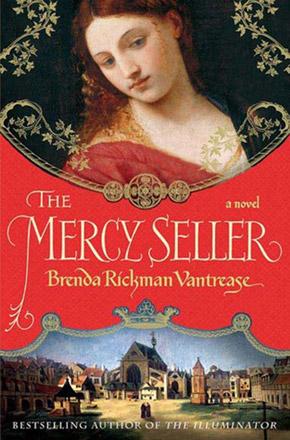You are here
‘A world that no longer made sense’
By Sally Bland - Apr 23,2017 - Last updated at Apr 23,2017

The Mercy Seller
Brenda Rickman Vantrease
New York: St. Martin’s Press, 2007, 422 pp
This historical novel opens in the year 1410 with a book burning in Prague, Bohemia, a centre for the Lollard movement begun by John Wycliffe in England, who translated the Bible into English and preached against the church’s corruption. “Today, it was only books — only holy words consigned to the flames, not the people who copied them — not flesh and blood and bone. But this was prelude to the greater drama.” (p. 1)
Drama is never lacking in this sequel to “The Illuminator” (reviewed in “The Jordan Times”, October 24, 2016), as two opposing sides face off against each other. On the one hand is the Lollards who insist on people’s right to read the holy scriptures in their own language, and that forgiveness comes from God and is not to be sold by the church in the form of indulgences. On the other hand is the church hierarchy, which, determined to preserve its wealth and power, is pressuring the state to crack down on the Lollard reformists. As the Archbishop of Canterbury says to the King: “Whenever Lollardy has been preached there have been uprisings. The commoners feel empowered by the reading of the word for themselves. They no longer rely on the church. They say they answer only to Christ himself. Not to the archbishop… Or to the king.” (p. 343)
Author Brenda Rickman Vantrease greatly augments the built-in drama of this tumultuous historical period with her intricate plot and the particular life trajectories of her characters. While “The Illuminator” revolves around two strong protagonists, Finn and Kathryn, who know exactly who they are, “The Mercy Seller” tells the story of Anna and Gabriel who assume different and sometimes conflicting roles, at times disguising their true identities, lying and compromising on their principles. Yet, their respective zig-zags are not due to dishonesty, but to the impossible circumstances in which they find themselves as the conflict between the church and the Lollards escalates.
Rotating between Bohemia, France and England, “The Mercy Seller” continues the saga, thirty years on, of Finn who illustrated the first Wycliffe Bible, and Kathryn, a noblewoman sympathetic to the Lollard cause. When catastrophe befalls them, Kathryn secludes herself in an abbey in England, while Finn takes refuge in Prague where he raises his orphaned granddaughter, Anna. Once lovers, they do not know what has happened to each other, yet they follow parallel tracks. Under Kathryn’s discrete guidance, the nuns of the abbey copy holy texts, including the forbidden English translations. Finn continues his illuminations, while gathering dissident students to study, translate and copy the banned books in Czech. Anna grows up in a world of equality, faith and books, and acquires her own bookmaking and translation skills which later allow her to make a living, but also expose her to charges of heresy.
When Finn dies, the noose is tightening around the Lollards in Prague, and Anna decides to follow his instructions to seek safety with Sir John Oldcastle in England, not knowing that he too has been targeted for his Lollard activities. She sets out on an eye-opening but perilous journey, initially travelling with a band of Roma and adopting a handicapped but musically talented child who later proves to be her salvation. But most of all, she feels totally alone: “Anna mourned her loss of connectedness in a world that no longer made sense.” (p. 133)
In Rheims, Anna and Gabriel, each pretending to be someone they are not, meet and fall in love, but what will happen when they revert to being themselves?
Gabriel would seem to be on the opposite side. He is a monk who sells indulgences, i.e., the mercy seller, and charged by the archbishop to spy on the Lollards. But Gabriel’s story, like that of many other characters in the book, is not what it seems. He and Anna actually have much in common. Both have been raised as orphans, knowing little of their mothers or their past. While Finn kept secrets from Anna to protect her, Gabriel was the victim of outright deception: A priest falsely claimed to have saved him from his allegedly prostitute mother and raised him in a monastery.
As the lives of these characters crisscross, converge and collide, there is much fear, suspicion, agonising and divided loyalties as each tries to navigate the perils of the church’s witch hunt. There are also many self-discoveries and reunions with lost loved ones. Quite amazingly, the author ties the many threads of the plot into a coherent whole which gives hope, but not the facile satisfaction of a contrived happy ending.
Questions of faith, the importance of the written word, and the freedom to read and write in one’s mother tongue, are at the heart of the story. The parallel theme is the destructiveness of intolerance, giving this novel current as well as historical relevance. As Vantrease writes in the author’s note: “The Lollard persecutions continued until the Reformation. Many men and women were tortured and executed for religious dissent… Unfortunately, such religious intolerance did not end with the Reformation.” (p. 422)
Related Articles
The IlluminatorBrenda Rickman VantreaseNew York: St. Martin’s Griffin, 2005Pp.
The Kindness of EnemiesLeila AboulelaNew York: Grove Press, 2017Pp.
The Japanese LoverIsabel AllendeTranslated by Nick Caistor and Amanda HopkinsonNew York: Atria Books, 2015Pp.
















